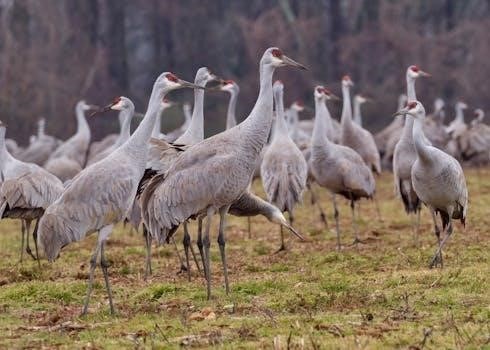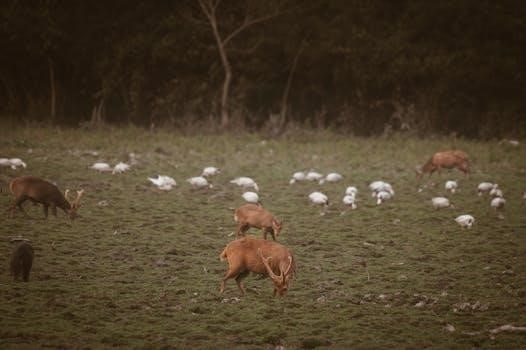Embark on a birding adventure with Montana’s best-selling guide! Identify local birds easily and enhance your bird-watching experience. This simple and informative guide makes bird identification enjoyable for all skill levels in Montana.
Montana‚ with its diverse landscapes‚ offers a rich environment for birding. From the mountains to the prairies‚ a wide variety of bird species call Montana home. Birding in Montana is an accessible activity‚ whether you’re a seasoned birder or just starting out. It’s a simple and enjoyable way to connect with nature. Many begin by observing birds at their feeders‚ which can spark a lifelong interest in bird identification. Get ready to discover the beauty and diversity of Montana’s avian life. Remember to respect wildlife and their habitats during your birding adventures‚ ensuring these remarkable creatures can thrive for future generations. Happy birding in Big Sky Country!

Identifying Montana Birds
Identifying Montana birds involves observing key features such as size‚ color‚ and behavior. A good field guide is essential. Learning bird songs also aids in recognition and adds to the birding experience in Montana.
Using a Field Guide for Identification
A field guide is an indispensable tool for identifying Montana birds. Begin by familiarizing yourself with the guide’s organization‚ often by color‚ size‚ or habitat. When you spot a bird‚ note its overall appearance and compare it to the illustrations in the guide. Pay attention to key markings‚ such as wing bars‚ eye stripes‚ or tail patterns.
Read the description carefully‚ noting the bird’s size‚ typical behavior‚ and habitat. Consider the location where you saw the bird‚ as some species are more common in certain areas of Montana. Range maps in the guide can help confirm if the bird is likely to be found in your region. Remember that bird plumages can vary with age and season‚ so consult multiple illustrations if available.
Key Features for Bird Identification
Identifying birds effectively relies on observing key features. Start with size and shape; is it robin-sized‚ sparrow-sized‚ or hawk-sized? Note the bird’s overall silhouette‚ including the length of its tail and wings. Pay close attention to plumage colors and patterns. Look for distinctive markings like eye stripes‚ wing bars‚ or streaked breasts. The color of the bill and legs can also be helpful.
Observe the bird’s behavior. How does it move? Does it hop‚ walk‚ or climb? What is it eating? Listen carefully to its song or call. Bird vocalizations are often unique to each species. Consider the habitat where you found the bird. Is it in a forest‚ field‚ or near water? Combining these features will significantly improve your bird identification skills in Montana.

Common Birds of Montana
Montana boasts a rich variety of birdlife. Among the most frequently observed species are the Black-billed Magpie‚ Western Meadowlark‚ and the adaptable Black-capped Chickadee‚ making them familiar sights.
Black-billed Magpie
The Black-billed Magpie‚ a common sight in Montana‚ is known for its striking black and white plumage and long tail. Often regarded as one of the smartest birds‚ the Magpie exhibits complex behaviors. It’s frequently observed in open areas‚ perched on fences‚ showcasing its adaptability. This bird is also very vocal‚ and often communicates with harsh chattering calls. Its presence is a testament to Montana’s diverse avian population. The Black-billed Magpie is highly adaptable‚ thriving in various habitats from urban environments to rural landscapes. Furthermore‚ their intelligence is evident in their problem-solving abilities and social interactions. This makes them fascinating subjects for birdwatchers and nature enthusiasts alike. The species is a symbol of Montana’s wildlife.
Western Meadowlark (State Bird)
The Western Meadowlark‚ Montana’s state bird‚ is celebrated for its melodious song and vibrant yellow breast. Its presence graces Montana’s prairies and grasslands‚ adding beauty to the landscape. This bird’s song is a familiar sound during Montana’s summer months‚ symbolizing the state’s natural heritage. The Western Meadowlark is an iconic representation of Montana’s wildlife‚ deeply rooted in the state’s identity. Often seen perched on fences‚ it is easily identifiable by its distinctive markings. Furthermore‚ its song is a complex series of flute-like notes‚ making it a favorite among birders. The Western Meadowlark’s diet consists mainly of insects and seeds. This helps control pest populations on farms and ranches. Its importance to the ecosystem is undeniable.
Black-capped Chickadee
The Black-capped Chickadee‚ a common sight in Montana‚ is known for its adaptability and cheerful demeanor. These small birds thrive in various habitats‚ including backyards and forests. Their distinctive “chick-a-dee-dee-dee” call is a familiar sound throughout the year. Black-capped Chickadees are remarkably resilient‚ surviving harsh Montana winters by caching food and lowering their body temperature. Their curiosity and acrobatic feeding habits make them delightful to observe. They frequent bird feeders‚ offering a welcome splash of activity. These birds are also known for their ability to remember the locations of hundreds of cached food items. This remarkable spatial memory is essential for their survival during lean times. Their small size belies their toughness and resourcefulness.

Bird Habitats in Montana
Montana’s diverse landscape provides a variety of bird habitats. From lush wetlands to dense forests and open prairies‚ each environment supports unique bird species. Explore these varied ecosystems.
Backyard Birds
Attract a variety of birds to your Montana backyard with the right setup. Provide feeders with seeds to entice finches‚ sparrows‚ and chickadees. Water sources‚ like birdbaths‚ are crucial‚ especially during dry months. Native plants offer food and shelter for many species.
Common backyard birds include the Black-capped Chickadee‚ Downy Woodpecker‚ and American Robin. You might also spot Red-breasted Nuthatches and Mountain Chickadees‚ especially in winter. Get a free identification chart to help you identify these common visitors. Watching birds at your feeder can spark a lifelong interest in bird identification and conservation.
Remember to keep your feeders clean to prevent the spread of disease among your feathered friends. Enjoy the beauty and diversity of Montana’s backyard birds!
Birds of Prey
Montana is a haven for magnificent birds of prey‚ also known as raptors. These skilled hunters play a vital role in the ecosystem. Montana is home to hawks‚ eagles‚ falcons‚ and owls‚ each adapted to different hunting strategies and habitats.
Look for the majestic Golden Eagle soaring over open country or perched on high vantage points. Bald Eagles are often found near rivers and lakes‚ preying on fish. Hawks‚ like the Red-tailed Hawk‚ are common sights along roadsides. Owls‚ such as the Great Horned Owl‚ hunt at night‚ using their acute hearing to locate prey.
Identifying birds of prey requires observing their size‚ shape‚ and flight patterns. A good field guide can help you distinguish between different species and understand their unique characteristics.
Water Birds
Montana’s diverse aquatic environments‚ from pristine mountain lakes to winding rivers and wetlands‚ provide crucial habitat for a variety of water birds. These birds are adapted to aquatic life‚ with features like webbed feet for swimming and long bills for foraging in the water.
Keep an eye out for ducks‚ geese‚ and other waterfowl that frequent Montana’s waterways. Mallards are among the most common‚ often seen dabbling in shallow water. Canada Geese are also abundant‚ especially during migration. Loons‚ with their haunting calls‚ can be found on larger lakes.
Wading birds like herons and egrets stalk their prey in shallow marshes. Observing these birds in their natural habitat is a rewarding experience. Using a field guide will help you identify the different species and learn about their behaviors.

Resources for Montana Birders
Enhance your birding with Montana’s resources! Consult the Montana Bird Records Committee (MBRC) for rare species data. Join Montana Audubon Society to connect and conserve Montana’s avian life;
Montana Bird Records Committee (MBRC)
The Montana Bird Records Committee (MBRC) plays a crucial role in maintaining an accurate record of bird species observed within the state. Since 1991‚ the MBRC evaluates all records of rare species‚ defined as those documented 20 or fewer times in Montana. This rigorous process ensures the validity of sightings and helps to track changes in bird populations over time.
The MBRC maintains the official list of Montana birds‚ which‚ as of December 15‚ 2024‚ includes 447 species. Their work is essential for understanding the distribution and abundance of various bird species across Montana’s diverse habitats. By carefully reviewing and documenting rare bird sightings‚ the MBRC contributes significantly to the conservation efforts in the state‚ providing valuable data for research and management decisions.
Montana Audubon Society
Founded in 1976‚ the Montana Audubon Society is an independent‚ statewide conservation organization dedicated to protecting Montana’s native birds‚ other wildlife‚ and natural ecosystems. The society’s mission is to promote appreciation‚ knowledge‚ and conservation of these vital resources‚ safeguarding biological diversity for current and future generations.
Montana Audubon achieves its goals through a variety of programs and initiatives‚ including advocacy‚ education‚ and scientific research. They work to influence policy decisions that impact bird habitats and populations‚ while also engaging the public through educational outreach. The society provides resources for birders of all skill levels‚ fostering a deeper understanding and appreciation for Montana’s rich avian diversity. They also actively participate in citizen science projects like the Great Backyard Bird Count.
Montana Bird Songs
Immerse yourself in the melodies of Montana’s diverse avian inhabitants. Bird songs offer a unique window into understanding species‚ behavior‚ and local ecosystems. A White-crowned Sparrow‚ for example‚ sings a different tune in the Sierras compared to Glacier National Park‚ highlighting regional variations.
For a truly immersive experience‚ consider exploring resources like Bruce Tannehill’s Western Montana Bird Songs CD‚ a collection of local bird vocalizations. This CD has been updated and offers a wonderful opportunity to learn the unique sounds of Montana birds. By listening closely‚ you can sharpen your identification skills and connect with the natural world on a deeper level. Bird songs are essential for any Montana birder.
